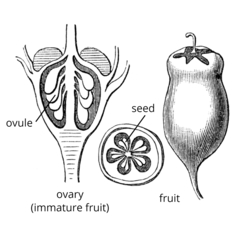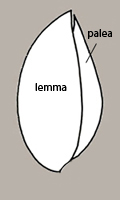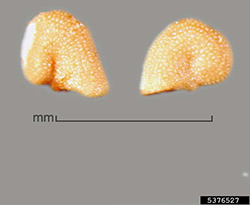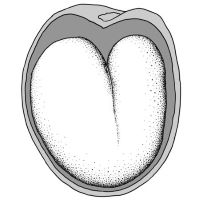Content is from Kirkbride et al. 2006Kirkbride et al. 2006:
Kirkbride JH, Jr, Gunn CR, and Dallwitz MJ. 2006. Family guide for fruits and seeds, vers. 1.0. Accessed September 2020-January 2022. URL: https://nt.ars-grin.gov/seedsfruits/keys/frsdfam/index.cfm ., without modification.
Updates are forthcoming.
Fruits: Pistil(s) compound; 1; 1-pistillate; with carpels united. Fruit pericarpium; simple; berryberry:
an indehiscent, fleshy fruit with one or a few to many seeds. The flesh may be homogenous throughout. Or, if the outer part is hard, firm, or leathery, referred to as an hesperidium. Septa are present in some, and the seeds may be arillate or with a fleshy testa. , or capsulecapsule:
, or capsulecapsule:
a dry, dehiscent fruit derived from a compound ovary , or drupedrupe:
, or drupedrupe:
(indehiscent drupe) a fleshy, indehiscent fruit with one more hard pits enclosing seeds, derived from single, superior, simple or compound ovary; (dehiscent drupe) a fruit with a dry or fibrous to fleshy or leathery outer husk that early to tardily breaks apart (or opens), exposing one or more nutlike pits enclosing the seeds (Mouriri but not Spjut); ceratium capsulecapsule:
(Mouriri but not Spjut); ceratium capsulecapsule:
a dry, dehiscent fruit derived from a compound ovary , or loculicidalloculicidal:
, or loculicidalloculicidal:
type of capsular dehiscence, opening longitudinally through the locules (compare septicidal)
 capsulecapsule:
capsulecapsule:
a dry, dehiscent fruit derived from a compound ovary , or septifragalseptifragal:
, or septifragalseptifragal:
type of capsular dehiscence, splitting through the exterior wall suture(s) but not the septum(-a), the valves of the wall then separating from the septum(-a) and the locules thus opened directly to the outside
capsulecapsule:
a dry, dehiscent fruit derived from a compound ovary ; capsulecapsule:
; capsulecapsule:
a dry, dehiscent fruit derived from a compound ovary not inflated; capsulecapsule:
not inflated; capsulecapsule:
a dry, dehiscent fruit derived from a compound ovary without operculumoperculum:
without operculumoperculum:
a dehiscent cap (or lid) of a seed or fruit that opens during germination or dehiscence ; berryberry:
; berryberry:
an indehiscent, fleshy fruit with one or a few to many seeds. The flesh may be homogenous throughout. Or, if the outer part is hard, firm, or leathery, referred to as an hesperidium. Septa are present in some, and the seeds may be arillate or with a fleshy testa. indehiscent, or dehiscentdehiscent:
indehiscent, or dehiscentdehiscent:
(v. dehisce) splitting open at maturity to release contents (of a fruit) (irregular in Astronia); berryberry:
(irregular in Astronia); berryberry:
an indehiscent, fleshy fruit with one or a few to many seeds. The flesh may be homogenous throughout. Or, if the outer part is hard, firm, or leathery, referred to as an hesperidium. Septa are present in some, and the seeds may be arillate or with a fleshy testa. without central placental mass; without persistent central column, or with persistent central column; with styles(s); at apexapex:
without central placental mass; without persistent central column, or with persistent central column; with styles(s); at apexapex:
the point farthest from the point of attachment, or the "tip" of an organ ; within accessory organ(s), or not within accessory organ(s); within calyxcalyx:
; within accessory organ(s), or not within accessory organ(s); within calyxcalyx:
the outer whorl of the perianth; all the sepals of a flower , or hypanthium (for berryberry:
, or hypanthium (for berryberry:
an indehiscent, fleshy fruit with one or a few to many seeds. The flesh may be homogenous throughout. Or, if the outer part is hard, firm, or leathery, referred to as an hesperidium. Septa are present in some, and the seeds may be arillate or with a fleshy testa. ); with hypanthium berriesberry:
); with hypanthium berriesberry:
an indehiscent, fleshy fruit with one or a few to many seeds. The flesh may be homogenous throughout. Or, if the outer part is hard, firm, or leathery, referred to as an hesperidium. Septa are present in some, and the seeds may be arillate or with a fleshy testa. (Almeda (1989): "following fertilization a single ovuleovule:
(Almeda (1989): "following fertilization a single ovuleovule:
organ that contains the egg and after fertilization, becomes the seed develops and the result is a fruit consisting of one to five suglobose lobes attached to the old hypanthium, each lobe separate from the other. Such a bizarre structure may in fact have the effect of increasing the dispersal of the seeds"); with hypanthium wall distinct from fruit wall (& persistent or crumbling & leaving irregular circularcircular:
develops and the result is a fruit consisting of one to five suglobose lobes attached to the old hypanthium, each lobe separate from the other. Such a bizarre structure may in fact have the effect of increasing the dispersal of the seeds"); with hypanthium wall distinct from fruit wall (& persistent or crumbling & leaving irregular circularcircular:
(of embryo) linear embryo is curved into an "O" shape rim); 1-seeded to many-seeded; 1-seeded (-many); less than 1 cm long to from 1–5 cm long (at least); 0.2–10 cm long; with (2–)5(–15)-carpellate (really (2-)3–5(-15)); with carpels united; with carpels remaining united at maturity; with carpels not radiating at maturity; without sterilesterile:
rim); 1-seeded to many-seeded; 1-seeded (-many); less than 1 cm long to from 1–5 cm long (at least); 0.2–10 cm long; with (2–)5(–15)-carpellate (really (2-)3–5(-15)); with carpels united; with carpels remaining united at maturity; with carpels not radiating at maturity; without sterilesterile:
lacking male and/or female reproductive parts; also, not producing fruit or seed
 carpels; not sulcatesulcate:
carpels; not sulcatesulcate:
surface relief—having one or more elongate, relatively narrow and shallow depressions or grooves ; in transection tereteterete:
; in transection tereteterete:
approximately circular in cross section; width and thickness approximately equal
 ; apexapex:
; apexapex:
the point farthest from the point of attachment, or the "tip" of an organ not beaked; dehiscentdehiscent:
not beaked; dehiscentdehiscent:
(v. dehisce) splitting open at maturity to release contents (of a fruit) , or indehiscentindehiscent:
, or indehiscentindehiscent:
not opening on its own, as in a fruit
 . Dehiscentdehiscent:
. Dehiscentdehiscent:
(v. dehisce) splitting open at maturity to release contents (of a fruit) unit seed(s). Dehiscentdehiscent:
unit seed(s). Dehiscentdehiscent:
(v. dehisce) splitting open at maturity to release contents (of a fruit) passively (assumed); and shedding seeds; without replumreplum:
passively (assumed); and shedding seeds; without replumreplum:
the rim, formed by the persistent placentas, and connected by a false septum in Brassicaceae fruits. The fruit valves are attached to this rim and separate from it in dehiscent fruits.
. Epicarpepicarp:
outer layer of fruit wall or pericarp, if divided into layers; note here used synonymously with exocarp brown (all shades), or black, or purple, or white, or red, or pink, or orange, or green; durable; glabrousglabrous:
brown (all shades), or black, or purple, or white, or red, or pink, or orange, or green; durable; glabrousglabrous:
without hairs
, or not glabrousglabrous:
without hairs
(with hairs); hairs medium length; hairs dense; hairs not glandularglandular:
surface relief—covered with small, raised secretory glands, regular or irregularly shaped, translucent or opaque, and maybe distinctly colored ; without armature, or with armature; with spines; without armature glochidiate; smooth, or not smooth; without wing(s); without apicalapical:
; without armature, or with armature; with spines; without armature glochidiate; smooth, or not smooth; without wing(s); without apicalapical:
at or pertaining to the end of the seed or fruit distal from its point of attachment (i.e., base)
respiratory hole. Mesocarpmesocarp:
the middle layer of the pericarp, if divided into layers absent, or present; very or more or less fleshy; composed of 1 unified layer; without lactiform cavity system. Endocarpendocarp:
absent, or present; very or more or less fleshy; composed of 1 unified layer; without lactiform cavity system. Endocarpendocarp:
the inner layer of the pericarp, if divided into layers present, or absent; not separating from exocarpexocarp:
present, or absent; not separating from exocarpexocarp:
outer layer of fruit wall or pericarp, if divided into layers; note here used synonymously with epicarp ; thin, or leatheryleathery:
; thin, or leatheryleathery:
texture—moderately thick, tough, and very pliable
; not splitting into 1-seeded pyrenes; smooth; without wing; without operculumoperculum:
a dehiscent cap (or lid) of a seed or fruit that opens during germination or dehiscence ; without secretory cavities; without mechanism for seedling escape; without grooves; without longitudinallongitudinal:
; without secretory cavities; without mechanism for seedling escape; without grooves; without longitudinallongitudinal:
of or relating to length or the lengthwise dimension
ridges. Funiculusfuniculus:
(alt. funicle) stalk connecting the ovule (later seed) to the ovary (later fruit) placenta short; short without seed bearing hookswith hooks:
short; short without seed bearing hookswith hooks:
bristles or spines with curved or backwards pointing tips, or with secondary bristles along their length (retinacula); not persisting in fruit after seed shed.
(retinacula); not persisting in fruit after seed shed.
Seeds: Arilaril:
(broad sense) appendicular structure that wholly or partly envelops a seed and is produced from or a modification of the funicle, raphe, or outer integument; usually fleshy or pulpy, sometimes spongy or tufted-capillate, often brightly colored absent, or present (Amphib lemmalemma:
absent, or present (Amphib lemmalemma:
in grasses, the lower of the two bracts subtending the flower or caryopsis (compare palea) , Calvoa, Gravesia, Veprecella); a true arilaril:
, Calvoa, Gravesia, Veprecella); a true arilaril:
(broad sense) appendicular structure that wholly or partly envelops a seed and is produced from or a modification of the funicle, raphe, or outer integument; usually fleshy or pulpy, sometimes spongy or tufted-capillate, often brightly colored , or an arillike structure (perhaps 2 is only answer - see rapheraphe:
, or an arillike structure (perhaps 2 is only answer - see rapheraphe:
a ridge or seam on the seed coat, formed by the portion of the funiculus united to the ovule wall in longitudinally curved ovules ). Arillike structure falling with seed an arillode. Seed minute to larger than minute; less than 1 mm long to 1 to less than 5 mm long; 0.3–8 mm long; reniformreniform:
). Arillike structure falling with seed an arillode. Seed minute to larger than minute; less than 1 mm long to 1 to less than 5 mm long; 0.3–8 mm long; reniformreniform:
2D or 3D shape—kidney-shaped , or irregular, or ovateovate:
, or irregular, or ovateovate:
2D shape—egg-shaped in outline, widest point is towards one end of the organ, the other end tapers gradually, attachment at or near the broad end (compare obovate, ovoid) , or oblongoblong:
, or oblongoblong:
2D shape—much longer than broad with nearly parallel sides, corners are rounded , or circularcircular:
, or circularcircular:
(of embryo) linear embryo is curved into an "O" shape , or triangulartriangular:
, or triangulartriangular:
2D shape—three relatively straight sides with distinct corners; more angular than teardrop-shaped , or cochleatecochleate:
, or cochleatecochleate:
snail-shell-shaped. Relatively broad and short, basically round in transverse section, resembling a rapidly tapering spire overall, the exterior helically convoluted; like a snail shell (scobiform (Huberia)); not bowl shaped; not nutlike; without winglike beakbeak:
(scobiform (Huberia)); not bowl shaped; not nutlike; without winglike beakbeak:
a usually firm, terminal appendage, sometimes tapered ; without caudatecaudate:
; without caudatecaudate:
tapering to a long, tail-like appendage appendage(s); at maturity without food reserves, or with food reserves; with endosperm; without canavanine. Sarcotestasarcotesta:
appendage(s); at maturity without food reserves, or with food reserves; with endosperm; without canavanine. Sarcotestasarcotesta:
pulpy or fleshy outer layer of the seed coat, simulates aril absent. Testatesta:
absent. Testatesta:
seed coat
 present; without markedly different marginalmarginal:
present; without markedly different marginalmarginal:
at, on, or close to the margin or border
tissue; without fleshy or leatheryleathery:
texture—moderately thick, tough, and very pliable
layer over hard layer; tight, or loose; dulldull:
reflecting only a low proportion of incident light, with no apparent sheen , or shinyshiny:
, or shinyshiny:
uniformly reflecting a high proportion of incident light at all angles (or apically shinyshiny:
(or apically shinyshiny:
uniformly reflecting a high proportion of incident light at all angles & basally dulldull:
& basally dulldull:
reflecting only a low proportion of incident light, with no apparent sheen ); surface smooth, or unsmooth; surface with depressed features, or discreet raised features, or merged raised features; surface pittedpitted:
); surface smooth, or unsmooth; surface with depressed features, or discreet raised features, or merged raised features; surface pittedpitted:
surface relief—surface with small depressions in which the areas between the hollows do not take on the appearance of a true reticular net , or punctatepunctate:
, or punctatepunctate:
surface relief—dotted with pits or with translucent, sunken glands or with colored dots, similar to pitted , or groovedgrooved:
, or groovedgrooved:
surface relief—linear depressions that may be single or form a series of grooves over the surface ; surface echinate (barbedbarbed:
; surface echinate (barbedbarbed:
(of awns or bristles) with short, sharp, hair-like projections
), or papillatepapillate:
surface relief—bearing minute, distinct, broad-based projections, tapering to a rounded apex , or tuberculatetuberculate:
, or tuberculatetuberculate:
surface relief—bearing small, warty, swelling, rounded, or variously shaped projections , or verrucoseverrucose:
, or verrucoseverrucose:
surface relief—warty, covered with wart-like projections
; surface roughenedroughened:
texture—having a small, stout, stiff, more or less acute protrusions
, or ribbedribbed:
surface relief—wide, prominent, linear ridges that are generally rounded and longitudinally situated on the surface (& complex), or wrinkledwrinkled:
(& complex), or wrinkledwrinkled:
surface relief—shallow, irregular folds and furrows covering the surface; appearing overall though crumpled and then spread out (& caryophyll-like); without crease or line separating cotyledons from hypocotyl-radicle, or with crease or line separating cotyledons from hypocotyl-radicle; without notch along margin where cotyledons from hypocotyl-radicle tip approach each other, or with notch along margin where cotyledons from hypocotyl-radicle tip approaching each other; without glands; without bristles; glabrousglabrous:
(& caryophyll-like); without crease or line separating cotyledons from hypocotyl-radicle, or with crease or line separating cotyledons from hypocotyl-radicle; without notch along margin where cotyledons from hypocotyl-radicle tip approach each other, or with notch along margin where cotyledons from hypocotyl-radicle tip approaching each other; without glands; without bristles; glabrousglabrous:
without hairs
; without wings, or with wing(s) (margined Castanella); without collar; without operculumoperculum:
a dehiscent cap (or lid) of a seed or fruit that opens during germination or dehiscence ; colored; monochrome; brown (all shades), or white, or black, or purple; crustaceouscrustaceous:
; colored; monochrome; brown (all shades), or white, or black, or purple; crustaceouscrustaceous:
texture—thin, dry, indurate, and brittle
; not becoming mucilaginousmucilaginous:
resembling mucilage; moist and sticky
when wetted; surrounding embryo. Hilumhilum:
on seeds, the scar indicating where the funiculus was attached; on grass caryopses, the scar visible on the outer fruit surface revealing where the seed is attached on the inner fruit wall surface; or in Asteraceae cypselae, the scar visible on the outer fruit wall revealing where the fruit was attached to the receptacle larger than punctatepunctate:
larger than punctatepunctate:
surface relief—dotted with pits or with translucent, sunken glands or with colored dots, similar to pitted ; basalbasal:
; basalbasal:
at or pertaining to the point of attachment; (of embryo) embryo occupies one end of the seed
(but size not known). Rapheraphe:
a ridge or seam on the seed coat, formed by the portion of the funiculus united to the ovule wall in longitudinally curved ovules conspicuous; spongyspongy:
conspicuous; spongyspongy:
soft, light, discontinuous but cohesive, and somewhat resilient
arilloid tissue (succulentsucculent:
texture—herbaceous and juicy, often thickened
& reddish-brown); as long as seed; included in dehisced fruit. Endosperm development nuclear. Embryo differentiated from food reserve; well developed; 1 per seed; completely filling testatesta:
seed coat
 (no food reserve); chamber central to wings; 1 times the length of food reserve; at one end of seed not extending into a depression or cup; straight, or bentbent:
(no food reserve); chamber central to wings; 1 times the length of food reserve; at one end of seed not extending into a depression or cup; straight, or bentbent:
(of embryo) embryo is bent at an acute, V-shaped angle with the ends close together and generally thick cotyledons , or arcuate, or J-shaped; parallel to seed length; without coleorhiza; without simmondsin; with cotyledons containing oils; without stomata; not green; with 2 or more cotyledons. Cotyledons 2; well developed; 0.2–0.4 times length of embryo; as wide as hypocotyl-radicle, or somewhat to significantly wider than hypocotyl-radicle; not concealing hypocotyl-radicle; not foliaceous, or foliaceous; flat, or convoluted, or crumpled; smooth; with apicesapex:
, or arcuate, or J-shaped; parallel to seed length; without coleorhiza; without simmondsin; with cotyledons containing oils; without stomata; not green; with 2 or more cotyledons. Cotyledons 2; well developed; 0.2–0.4 times length of embryo; as wide as hypocotyl-radicle, or somewhat to significantly wider than hypocotyl-radicle; not concealing hypocotyl-radicle; not foliaceous, or foliaceous; flat, or convoluted, or crumpled; smooth; with apicesapex:
the point farthest from the point of attachment, or the "tip" of an organ entire; with margins connate, or adhering; basally entire; equal in size, or unequal in size; more or less unequal, or markedly unequal (in irregularly shaped seeds); not punctatepunctate:
entire; with margins connate, or adhering; basally entire; equal in size, or unequal in size; more or less unequal, or markedly unequal (in irregularly shaped seeds); not punctatepunctate:
surface relief—dotted with pits or with translucent, sunken glands or with colored dots, similar to pitted dotted. Hypocotyl-radicle vestigial, or small; straight; not thickened, or much thickened; in pocket formed by testatesta:
dotted. Hypocotyl-radicle vestigial, or small; straight; not thickened, or much thickened; in pocket formed by testatesta:
seed coat
 therefore mostly separate from cotyledons.
therefore mostly separate from cotyledons.
Noxious weeds: 1 or more USA Federal noxious weeds in this family and 1 or more USA state noxious weeds in this family.
USA Federal Noxious Weeds:
Melastoma malabathricum L.: USA Federal Noxious Weed●; USA state noxious weed: FL●.
Symbols: ªaquatic weed; ●terrestrial weed; °weed in seed.
Last updated February 2006.
USA states and territories with listed noxious weeds: Florida (FL) and Hawaii (HI).
USA state and territory noxious weeds:
Clidemia hirta (L.) D. Don: USA state noxious weed: HI●°.
Medinilla venosa (Blume) Blume: USA state noxious weed: HI●°.
Melastoma malabathricum L.: USA Federal Noxious Weed●; USA state noxious weed: FL●.
Melastoma spp.: USA state noxious weed: HI●°.
Miconia spp.: USA state noxious weed: HI●°.
Oxyspora paniculata (D. Don) DC.: USA state noxious weed: HI●°.
Tibouchina spp.: USA state noxious weed: HI●°.
Symbols: ªaquatic weed; ●terrestrial weed; °weed in seed.
Last updated February 2006.
 : Moiriri, Votomita, berriesberry:
: Moiriri, Votomita, berriesberry: calyx and hypanthium may persist… or may crumble way … leaving an irregular circularcircular:
calyx and hypanthium may persist… or may crumble way … leaving an irregular circularcircular: rim".
rim".
Literature specific to this family: Whiffin, T. & A.S. Tombs. 1972. The systematic significance of seed morphology in the neotropical capsular-fruited Memecyleae. Amer. J. Bot. 59(4):411–422; Baumgratz, J.F.A. 1983–5. Morfologia dos frutos e sementes de melastomatáceas brasileiras. Arch. Jard. Bot. Rio de Janeiro 27:113–155; Morley, T. 1976. Memecyleae (Melastomataceae). Fl. Neotrop. Monogr. 15:1–295; Almeda, F. 1989. Five new berry-fruited species of tropical American Melastomataceae. Proc. Calif. Acad. Sci. 46:137–150.
General references: Baillon, H.E. 1866–95. Histoire des plantes, 13 vols. Hachette & Co., Paris, Corner, E.J.H. 1976. The seeds of Dicots, esp. vol. 2. Cambridge University Press, New York, Cronquist, A. 1981. An integrated system of classification of flowering plants, 1,262 p. Columbia University Press, New York, Flora Neotropica. 1968–74. Nos. 1–14. Hafner Publishing Company, Darien & 1976-. Nos. 15-present. New York Botanical Garden, Bronx [monograph number], Gaertner, J. 1788–1805. De fructibus et seminibus plantarum. The Author, Stuttgart, Goldberg, A. 1986 (dicots) & 1989 (monocots). Classification, evolution, and phylogeny of the familes of Dicotyledons. Smithsonian Contr. Bot. 58 for dicots (314 pp.) & 71 for monocots (74 pp.). [Goldberg's illustrations are reproduced from older publications and these should be consulted], Gray, A. 1848. Genera florae Americae boreali-orientalis illustrata, 2 vols. James Munroe & Co., Boston., Gunn, C.R. & C.A. Ritchie. 1988. Identification of disseminulesdisseminule:
detachable plant part capable of being disseminated and of propagating, commonly a seed or fruit
listed in the Federal Noxious Weed Act. Techn. Bull. U.S.D.A. 1719:1–313, Gunn, C.R., J.H. Wiersema, C.A. Ritchie, & J.H. Kirkbride, Jr. 1992 & amendments. Families and genera of Spermatophytes recognized by the Agricultural Research Service. Techn. Bull. U.S.D.A. 1796:1–500, LeMaout, E. & J. Decaisne. 1876. A general system of botany, 1,065 p. Longmans, Green, & Co., London, Mabberley, D.J. 1987. The plant-book, 706 p. Cambridge University Press, Cambridge, Roosmalen, M.G.M. van. 1985. Fruits of the Guianan flora, 483 pp. Institute of Systematic Botany, Wageningen Agricultural University. Drukkerij Veenman B.V., Wageningen, Spjut, R.W. 1994. A systematic treatment of fruit types. Mem. New York Bot. Gard. 70:1–182, and Wood, C.E., Jr. 1974. A student's atlas of flowering plants: Some dicotyledons of eastern North America, 120 pp. Harper & Row, New York.